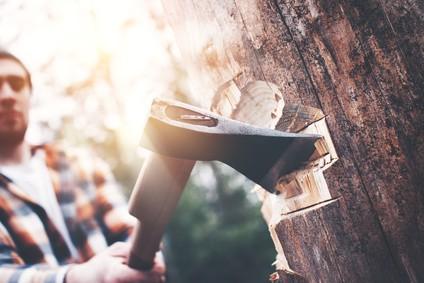
Wood is a great material for construction. It’s strong, easy to cut, readily available which means it is cost-effective, and it is also suitable for a variety of uses. These include but are not limited to woodworking, floors and decks, There are lots of different types, though, each with their own hardness, colour, and grain.
When using in large projects you’ll want to consider the strongest type of wood to provide as much resilience to the structure as possible, and in this article, we will be looking at the best options to choose from, especially if you need something tough.
Strongest Type of Wood: Why Is Some Wood Harder Than Others?
There are two main categories of wood – softwood and hardwood. The differences between the two are clear in their tree form, with hardwood trees typically having seeds that are surrounded in tough shells, and losing their leaves in the fall. Softwoods, on the other hand, generally have seeds that are uncovered, and will keep their leaves during the winter.
The wood itself is made from strands of cellulose fibres that are held together by lignin. The way these fibres are chained together is where wood gets its strength from because they spread the load across the entire length. You can see this structure in the grain, which is why it’s easier to split a board in line with the grain as opposed to across it.
Different species of trees align these chains in different ways, so some turn out to be much stronger than others. Hardwoods, for example, have longer growth cycles so the structures inside are far more compact. This is also why their growth rings are so much closer together than in softwood varieties.
The density of a wood is a good indicator of how strong it will be, and this is calculated by “Specific Gravity”- a number gained by dividing the weight of a set volume of the wood by the weight of the same volume of water.
Types of Strength in Wood
The properties of wood mean that some varieties are much better suited to particular uses than others, but using the overall word “strength” can be a little misguiding because there are different types of strength that are relevant for different uses.
The four important factors to consider are:
- Compressive Strength,
- Bending Strength,
- Stiffness, and
- Hardness.
What Is “Compressive Strength of Wood”?
Compressive strength describes how much weight the wood can handle when exerted in parallel to the grain. This is the type of strength that is important in table legs for example.
What Is “Bending Strength of Wood”?
This is how much weight the wood can handle when exerted perpendicular to the grain. This is the type of strength that is important when hanging something on a peg for example. Bending strength is also referred to as the modulus of rupture.
What Does “Stiffness of Wood” Mean?
Stiffness relates to how much the wood will bend when weight is applied perpendicular to the grain. An example of this is how much a shelf will droop. This effect is also referred to as the modulus of elasticity.
What Does “Hardness of Wood” Mean?
This is how resilient the finished wood piece will be to scratches, dents, and knocks. An example of this will be a kitchen counter and how long it remains looking like new without pieces chipping off.
The Strongest Wood For Furniture and Other Uses
American hardwoods are, unsurprisingly, stronger than the softwoods, so we will focus on these alongside some varieties from around the world. If we take the density (specific gravity) as the best guide to strength, the order of hardest wood in North America are the following types of timber.
What Is the Hardest Wood in North America by Density?
- Hickory (Specific Gravity of 0.72)
- White Oak (Specific Gravity of 0.68)
- Beech (Specific Gravity of 0.64)
- Hard Maple (Specific gravity of 0.63)
- Red Oak (Specific Gravity of 0.63)
To give an indication of how much stronger these are than softwoods, the strongest by this measure is yellow pine. There are a couple of woods from around the world that are harder than Hickory, such as Brazilian Rosewood (Specific Gravity of 0.8) and Indian Rosewood (Specific Gravity of 0.75).
While the density, or specific gravity, of the wood can be a good indicator of strength, there are also ways to measure the specific strengths for each of the four important factors that were mentioned earlier.
What Is the Hardest Wood in the World for Furniture, Floors and Construction?
If you are looking for the strongest wood or heaviest wood in the world for wooden construction, furniture or hardwood floors, the top ones are as follows:
- Compressive Strength: Hickory, Yellow Birch, and Hard Maple
- Bending Strength: Hickory, Yellow Birch, and Hard Maple
- Stiffness: Hickory, Yellow Birch, and Red Oak
- Hardness: Hard Maple, White Oak, and Ash
Even though these woods are the hardest ones, most American hardwoods will be suitable for all but the most intensive projects. So, factors like availability, sustainability and cost are more of a priority.
Wrap up
Timber is such a great natural resource that is perfect for use in construction. It comes in all sorts of different strengths and colours, with each one being far better for some uses than for others. If you’re looking for the strongest type of wood that is found in North America, then the answer is Hickory – but with Oak and Beech coming close behind.
If you are interested in working with wood, find more articles and guides in our dedicated section on woodworking.
